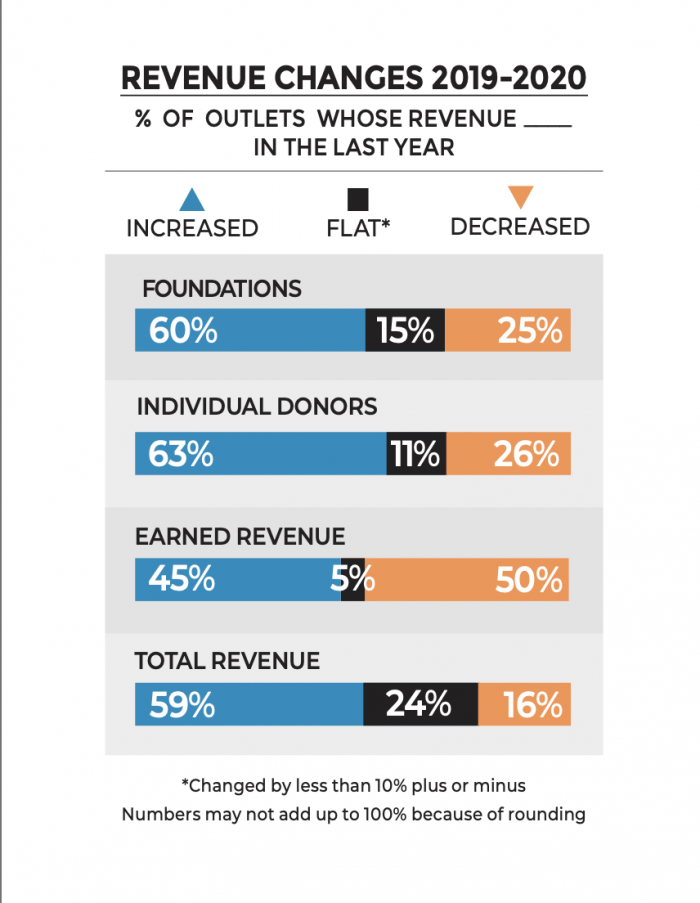
Despite the chaos and uncertainty of 2020, it was a year of journalistic and financial growth for the nonprofit news industry, leaders said at the Institute for Nonprofit News’ annual conference last week. On Tuesday, INN released its annual report with more details.
Emily Roseman, INN’s research director, and Jesse Holcomb, an assistant professor of journalism and communication at Calvin College, said that INN members rose to every challenge the past year presented them with. Roseman and Holcomb believe that the increase in service journalism and the increase in NewsMatch donations has led to this type of growth.
From the report:
Individual giving is where nonprofit outlets shined in 2020. The median revenue from individual giving increased to $118,000, a 41% gain from the prior year based on the Index respondents with comparable 2019 and 2020 financial data. …
Nearly two-thirds of news nonprofits saw increases in individual giving in 2020, and for about half of those outlets the bump was more than 50%. Individual giving includes gifts from major donors, mid-range donors, small-dollar donors and members.
The majority of individual giving revenue comes from major donors (60%), followed by small-dollar contributors (22%), members (9%) and mid-range donors (7%).
INN surveyed 284 INN network newsrooms in January 2021, and 264 (94%) responded (the survey excludes service organizations that are also INN members). Of those newsrooms surveyed, 36% cover local issues, 24% cover state issues, and 21% are national outlets, while the remaining 10% and 9% are global and regional, respectively.
“Some [INN] members started up direct services for their audiences, others covered and gave context to the anti-racism movement last year, and reporters around the country put on their masks and conducted socially distant interviews with sources,” Roseman said. “It was just such a crazy and challenging year, and we just saw how nonprofit newsrooms kept producing coverage and stories for the public throughout.”
“Specialized reporting has migrated to nonprofits, many of which have become the ‘beat reporters’ for other media,” the report notes.
INN members published an average of 1,000 stories a day in 2020. On average, the survey found an increase in web traffic of 43% over 2019 and an increase in email newsletter signups of 36% across its member organizations, from a median of 5,300 subscribers in 2019 to around 7,200 in 2020. About 69% of responding newsrooms said they make a direct effort to cover communities of color and 21% said their primary mission is to do so. Holcomb said that going forward, the challenge for INN members will be to sustain and build on that growth.
INN projected that the total revenue among its members was $350 million in 2020 — but cautioned it’s not easy to compare that to years past:
While this estimate reflects a growing field and increased funding, it is not easily comparable to previous years’ Index estimates for two reasons. First, in the past, INN’s public media members were included in the totals; last year that put the total field-wide revenue at around $500 million. This year, INN excluded public media groups from our financial analyses due to barriers with aligning public media accounting with the majority of digital-native outlets. Second, we made a slight modification to this year’s survey to filter out non-news related revenue at organizations that have broader missions.
 There was an increase in foundation support and individual giving for nearly two-thirds of nonprofit news outlets, but a decrease in earned revenue for about half.
There was an increase in foundation support and individual giving for nearly two-thirds of nonprofit news outlets, but a decrease in earned revenue for about half.
“Nonprofit news outlets attracted more first-time contributors than ever before,” the report notes. “The number of people who gave a nonprofit news outlet a small-dollar contribution jumped by almost 50% from 2019 to 2020, from an average 846 small-dollar donors per outlet in 2019 to over 1,200 in 2020. The average amount of a small-dollar donation held steady at around $90.”
Local, state and regional, and national and global nonprofits all count on foundation funding for an average of 47% of their revenue. But that funding disproportionately goes to national and global outlets, especially older ones:
The outlets that are attracting the most grant dollars are well established, tend to be nationally or globally focused, and have larger overall budgets. More than 70% of all grant funding goes to just the top 20% of the field, a group of outlets with annual revenue of $2 million or more. Older outlets that launched in 2008 or before make up roughly one-fifth of the field, but bring in more than a third of all grant money.
Major giving is also concentrated disproportionately among older and national outlets. Of all the outlets that reported major gifts, just 9% brought in at least $1 million from this source in 2020. That 9% — a group dominated by older, nationally focused newsrooms — accounted for nearly three-quarters of all major donor revenue across the field.
One of the main drivers of the increase in individual donations is NewsMatch, which INN calls “the largest collective fundraising campaign for nonprofit news.”
“NewsMatch has created pathways for local and regional funders, philanthropists and small businesses to invest in independent news outlets with these local matching funds,” Roseman said. “We are seeing national philanthropic dollars being used as catalysts to garner local public and community support, and the really exciting thing is that we’re seeing the effect of this catalyst to grow over time.”
 In 2020, it’s estimated that more than 16,000 journalists, many working at mainstream, commercial news outlets, lost their jobs due to the pandemic. In the nonprofit sector, however, employment grew to 2,700 nonprofit news workers. 2,000 are journalists or work on the editorial side of their operation.
In 2020, it’s estimated that more than 16,000 journalists, many working at mainstream, commercial news outlets, lost their jobs due to the pandemic. In the nonprofit sector, however, employment grew to 2,700 nonprofit news workers. 2,000 are journalists or work on the editorial side of their operation.
While there’s been growth in newsroom diversity, nonprofit leadership remains mostly white.
“In 2020, we found that 37% of nonprofit news outlets had a staff where people of color made up at least 40% of personnel,” Holcomb said. “In 2019, that number was at 21% of outlets that had that share. Despite some gains in newsroom diversity, leadership is predominantly white across the field. For our analysis, we were able to isolate newsroom execs and other staff, and among execs in the field, 74% are white, and among non-executive staff, 57% are white.”
The priorities for news leaders should be to prioritize diversity, equity and inclusion at the executive level, focus on audience retention and audience growth, and lean into individual giving, Holcomb and Roseman said.
Read the full report here.